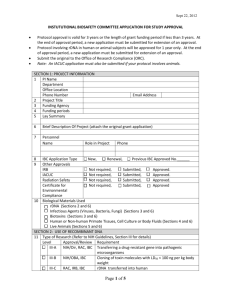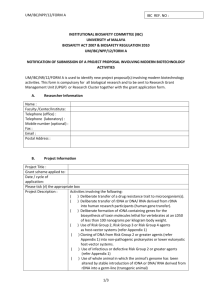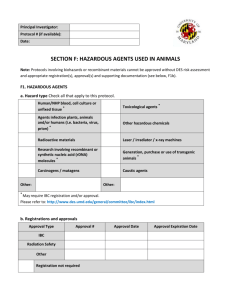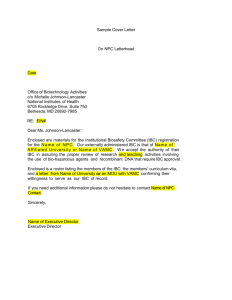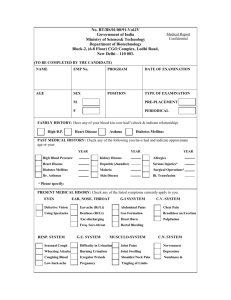IBC Registration Form
advertisement
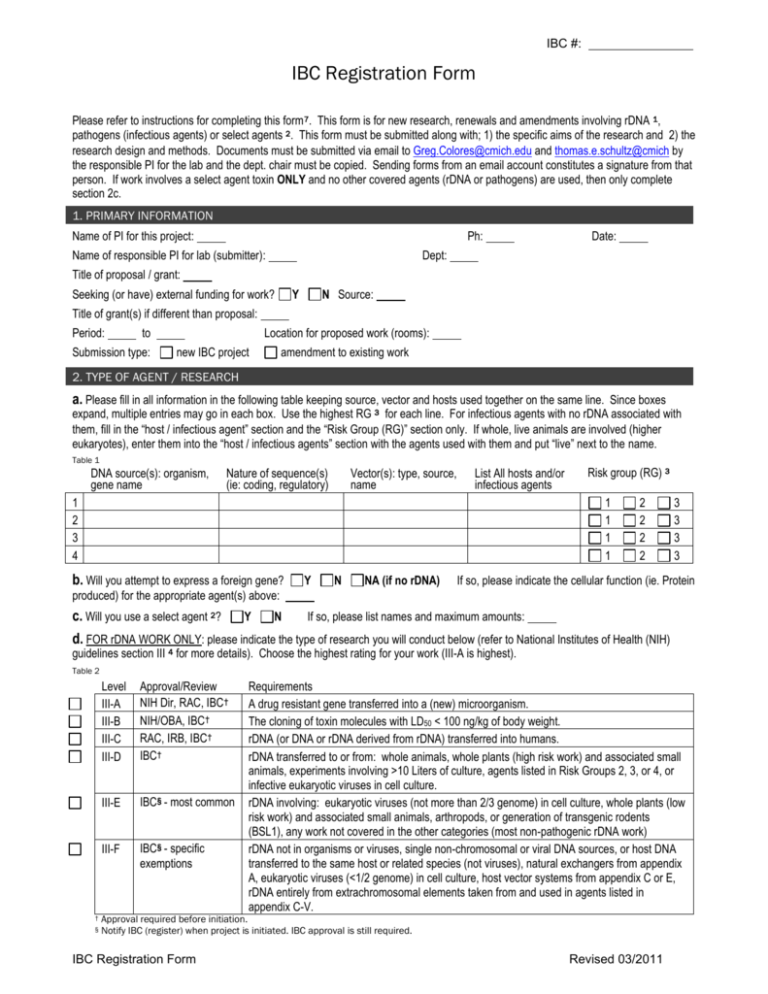
IBC #: IBC Registration Form Please refer to instructions for completing this form7. This form is for new research, renewals and amendments involving rDNA 1, pathogens (infectious agents) or select agents 2. This form must be submitted along with; 1) the specific aims of the research and 2) the research design and methods. Documents must be submitted via email to Greg.Colores@cmich.edu and thomas.e.schultz@cmich by the responsible PI for the lab and the dept. chair must be copied. Sending forms from an email account constitutes a signature from that person. If work involves a select agent toxin ONLY and no other covered agents (rDNA or pathogens) are used, then only complete section 2c. 1. PRIMARY INFORMATION Name of PI for this project: Ph: Name of responsible PI for lab (submitter): Date: Dept: Title of proposal / grant: Seeking (or have) external funding for work? Y N Source: Title of grant(s) if different than proposal: Period: to Submission type: Location for proposed work (rooms): new IBC project amendment to existing work 2. TYPE OF AGENT / RESEARCH a. Please fill in all information in the following table keeping source, vector and hosts used together on the same line. Since boxes expand, multiple entries may go in each box. Use the highest RG 3 for each line. For infectious agents with no rDNA associated with them, fill in the “host / infectious agent” section and the “Risk Group (RG)” section only. If whole, live animals are involved (higher eukaryotes), enter them into the “host / infectious agents” section with the agents used with them and put “live” next to the name. Table 1 DNA source(s): organism, gene name Nature of sequence(s) (ie: coding, regulatory) Vector(s): type, source, name List All hosts and/or infectious agents 1 2 3 4 Risk group (RG) 3 1 1 1 1 b. Will you attempt to express a foreign gene? Y N NA (if no rDNA) 2 2 2 2 3 3 3 3 If so, please indicate the cellular function (ie. Protein produced) for the appropriate agent(s) above: c. Will you use a select agent 2? Y N If so, please list names and maximum amounts: d. FOR rDNA WORK ONLY: please indicate the type of research you will conduct below (refer to National Institutes of Health (NIH) guidelines section III 4 for more details). Choose the highest rating for your work (III-A is highest). Table 2 † § Level III-A III-B III-C III-D Approval/Review NIH Dir, RAC, IBC† NIH/OBA, IBC† RAC, IRB, IBC† IBC† III-E IBC§ - most common III-F IBC§ - specific exemptions Requirements A drug resistant gene transferred into a (new) microorganism. The cloning of toxin molecules with LD50 < 100 ng/kg of body weight. rDNA (or DNA or rDNA derived from rDNA) transferred into humans. rDNA transferred to or from: whole animals, whole plants (high risk work) and associated small animals, experiments involving >10 Liters of culture, agents listed in Risk Groups 2, 3, or 4, or infective eukaryotic viruses in cell culture. rDNA involving: eukaryotic viruses (not more than 2/3 genome) in cell culture, whole plants (low risk work) and associated small animals, arthropods, or generation of transgenic rodents (BSL1), any work not covered in the other categories (most non-pathogenic rDNA work) rDNA not in organisms or viruses, single non-chromosomal or viral DNA sources, or host DNA transferred to the same host or related species (not viruses), natural exchangers from appendix A, eukaryotic viruses (<1/2 genome) in cell culture, host vector systems from appendix C or E, rDNA entirely from extrachromosomal elements taken from and used in agents listed in appendix C-V. Approval required before initiation. Notify IBC (register) when project is initiated. IBC approval is still required. IBC Registration Form Revised 03/2011 IBC #: 3. RISK ASSESSMENT Y N Is there any reason to believe any of the following things would be different in your work from the RG level identified in Table 1? (ie: virulence, pathogenicity, infectious dose, environmental stability, host range, cell cycle, replication capacity). NA (not a pathogen) Are there biological barrier options available (ie: attenuation) that would limit any of the above characteristics? NA (no rDNA) Will the insertion encode for an oncogene, integrate into the genome of any host or generate replicationcompetent viruses? NA (not a pathogen) Is an effective prophylaxis and/or treatment available? Will work involve large volumes (>10 Liters) or high concentrations? Is there the potential for aerosols to be generated? Please explain any yes answers and give any reasons for raising or lowering the original RG level: 4. CONTAINMENT Each line in Table 3 corresponds to the same number in Table 1. Section III (Table 1) 5 of the publication Biosafety in Microbial and Biomedical Laboratories (BMBL) defines biosafety Levels (BSL) for working with biologicals. Please check the appropriate containment level for the work proposed. Work involving mammalian cells must be BSL2 or higher. Check animal biosafety level (ABSL) only if working with whole, live, vertebrates. Table 3 – row numbers correspond to agents in table 1 1 Biosafety level (BSL) 1 2 3 Animal biosafety level (ABSL) NA 1 2 3 2 1 2 3 NA 1 2 3 3 1 2 3 NA 1 2 3 4 1 2 3 NA 1 2 3 IACUC #s (if applicable) 5. SAFETY PROTOCOLS a. Special provisions or practices for this work: b. If a pathogen is used a written safety protocol is required that explains how all infectious materials are handled safely in each step of the process including: procurement and storage of agents, protective equipment, biosafety cabinet use, how solid and liquid waste is handled, training, other equipment used (ie: centrifuge, sonication) and sharps handling. c. If a pathogen is used with live vertebrates, please submit the IACUC safety form (last page of the IACUC A form) for each protocol. IBC Chair: __________________________________ _________ signature date Biosafety Officer: __________________________________ _________ References links: 1. The definition of recombinant DNA 2. http://www.selectagents.gov/Select Agents and Toxins List.html 3. http://oba.od.nih.gov/oba/rac/Guidelines/APPENDIX_B.htm - AppxB_Tbl1 4. Classification of rDNA research 5. http://oba.od.nih.gov/oba/rac/Guidelines/NIH_Guidelines.htm 6. http://www.cdc.gov/biosafety/publications/bmbl5/index.htm 7. IBC registration form guide IBC Registration Form signature date Revised 03/2011


